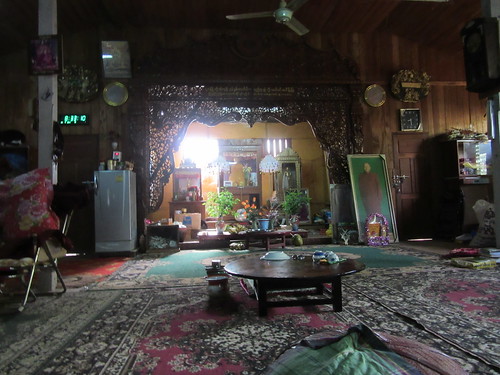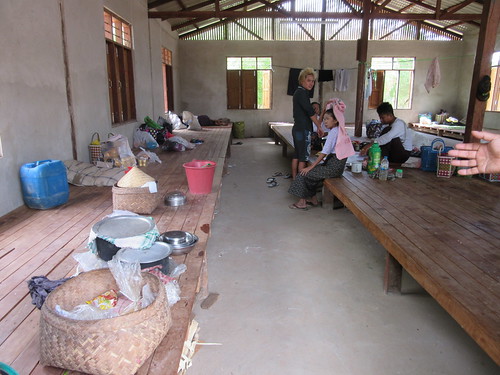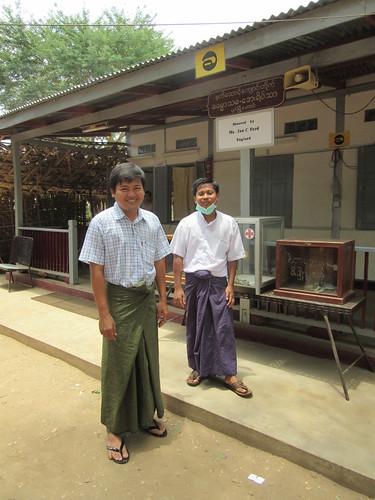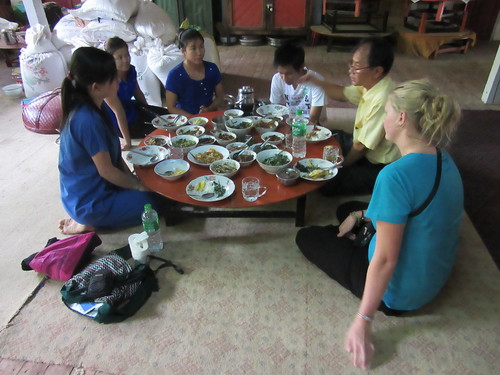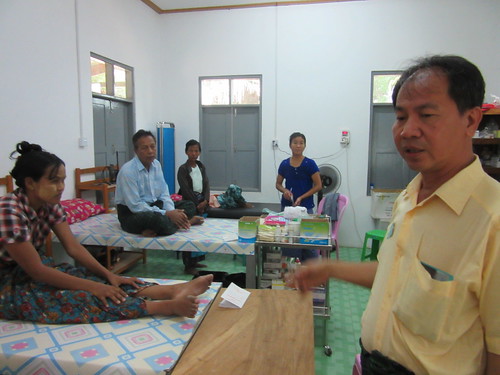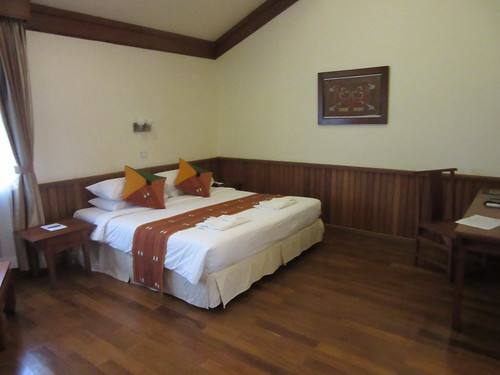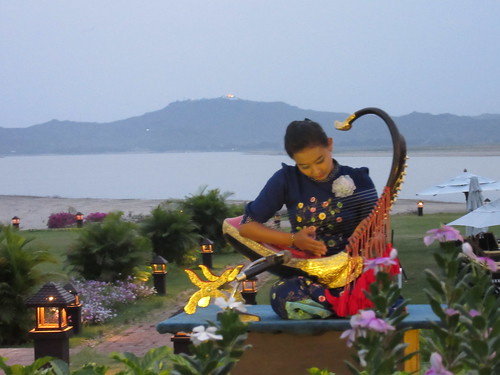Saturday 25th April 2015
After a good night's sleep at the Bagan Thiripyitsaya Sanctuary Resort, I took breakfast before exploring more of the hotel grounds. Adjacent to the hotel access road, I'd seen a restored temple and I examined this more carefully. A sign informed me that the site was the Kaladha Koun monastic complex, dating from the 13th century. Some parts remained only as ruined brick walls but the one temple had been restored. A marble tablet commemorated the completion of this work, sponsored by the hotel on 2nd May, 1998.
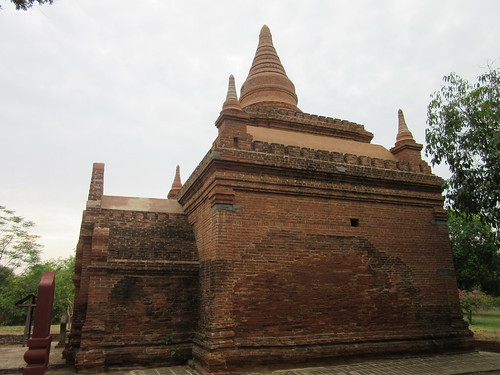 The restored temple in the hotel grounds.
The restored temple in the hotel grounds.
A little after 08:00, a car arrived to pick me up. We drove to Emily's hotel to collect her and we were then taken to the Bagan Clinic. When we arrived, about 150 patients had registered but when I enquired later in the day, that number had already risen to 250 and the 'List' had not been closed so the final total for the day may have been higher.
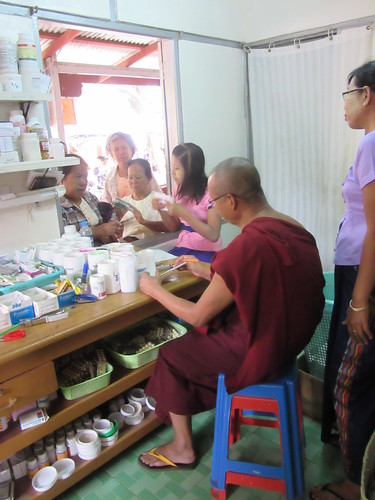
Patient registration.
The newly-qualified Burmese doctor we'd met the previous day was joined by a newly-qualified Chinese-American Doctor and they were allowed to practice their diagnostic skills. Of course, this meant that Dr. Hla Tun was frequently interrupted to confirm the correct diagnosis and treatment.
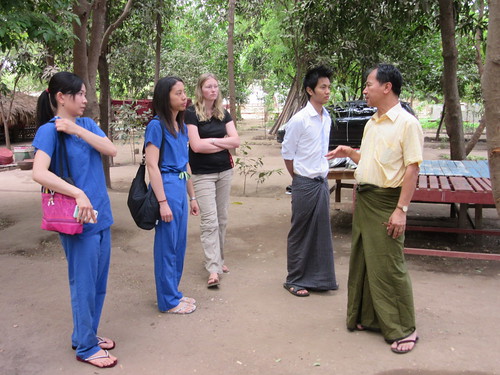 The two newly-qualified doctors (in blue 'scrubs') are briefed by Dr. Hla Tun.
The two newly-qualified doctors (in blue 'scrubs') are briefed by Dr. Hla Tun.
On initial registration, each new patient is issued with a record book with basic information. This is handed to the doctor giving treatment and completed to show the details of treatment. This book is then retained by the patient and, should further treatment be required, the record book is brought back by the patient when registering.
Dr. Hla Tun's Treatment Room
Dr. Hla Tun is assisted by two dedicated members of staff whom he has trained and give him high-quality support.
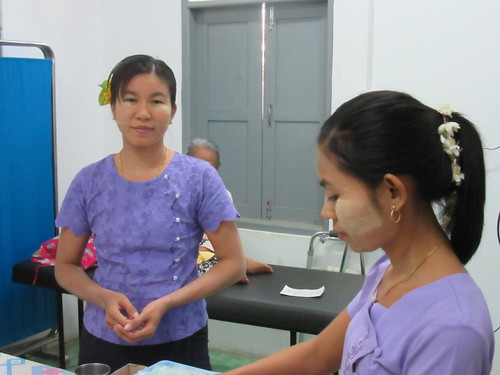 Dr. Hla Tun's assistants.
Dr. Hla Tun's assistants.
The treatment room in which they work has three examination couches and various racks holding commonly-used items. A remarkable number of injections are required and the assistants will pre-prepare a small number of various injections to reduce the treatment time.
 Pre-prepared injections.
Pre-prepared injections.
When a patient is 'referred' to Doctor Hla Tun by one of the clinic doctors, the patient's record book is placed in order on a pile in the treatment room. As each patient's treatment is completed, Dr. Hla Tun writes up their record book which is returned to the patient. The next record book on the pile identifies the patient to be called in from the covered waiting area immediately outside the treatment room. This is done by one of the assistants who measures blood pressure and obtains details of the problem whilst Dr. Hla Tun is attending the patient on the third examination couch. There is thus no wasted time as one patient leaves and the next enters.
As necessary, Dr. Hla Hun will carry out checks with a stethescope, check the pulse and carry out simple diagnostic tests. He will ask the patient additional questions, and this occasionally brings problems. Because patients often travel long distances from other parts of Myanmar to reach the clinic, they may speak in an unfamiliar dialect with the possibilities for misunderstanding.
Additional Tests
Through the generosity of donors, it has been possible to add a well-equipped laboratory and various blood and urine tests are produced as required. An electro-cardiograph machine allows heart performance to be monitored and ultra-sound facilities are being added. A standard lab report form is completed by the Doctor indicating the required tests and the patient takes this to the laboratory, returning later with the results added to the same form by the technician.

A completed lab report form.
Additional Facilities
Many patients display impaired mobility and joint pain from a variety of causes. The availability of a well-equipped physiotherapy unit at the clinic offers the possibility of helping patients to improve their situation.
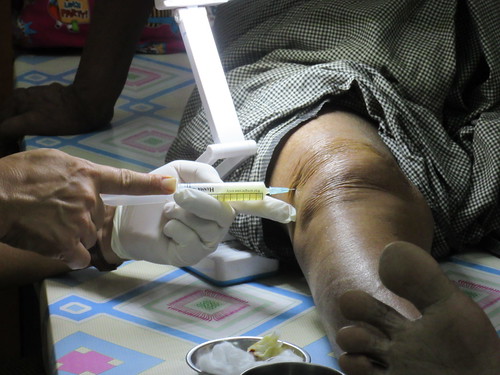 Treating knee problems.
Treating knee problems.
Lunch and beyond
Once again, the Doctor broke-off at 11:30 to show his visitors the distribution of the free lunch. This time, the Head Monk and Emily shared the handing out of the plates of food whilst I, with help from the jolly Monk who calls patients for their initial assessment, handed out the pressed metal spoons.
 Distribution of free lunch.
Distribution of free lunch.
The Doctor had hoped to break for his own lunch at about one o'clock but some tricky cases (one requiring an infusion) meant it was after 14:20 before his morning surgery was finished. Once again, we were treated to lunch in the monastery.
 Lunch in the monastery.
Lunch in the monastery.
At the start of Dr. Hla Tun's afternoon surgery, three patients were brought in initially but, thereafter, as one patient left, another was admitted whilst the doctor was treating one of the other two patients. Each patient may require a number of injections but if the injections are straightforward, they may be carried out by one of the Doctor's assistants. The aim is to reduce lost time so that, as far as practical, the doctor and his two assistants are each working with a different patient.
 Back treatment.
Back treatment.
Physical Records
Doctor Hla Tun has always insisted on comprehensive records. In addition to the patient's record book, written records are maintained at the clinic about treatments given. There is not a computer in sight but the Doctor can extract statistics in various ways. A surprising statistic is that, although the original concept was to provide health services to the Bagan area, now 90% of patients are from outside the Bagan area. Neither the Head Monk nor Dr. Hla Tun have any reservations about the involuntary expansion of services. They continue to aim to offer the best service possible.
I feel privileged to be able to report on this inspirational project but note that all errors are my own.
An Interlude
During the afternoon, I decided to explore the local area a little more. The monastery compound which houses the clinic is on a sandy cliff overlooking the Ayeyarwaddy River. Steep concrete-faced steps led down to the river, with a tablet acknowledging the donor:-
"The renovation of the stair case, its steps and railings is meant for the welfare and wholesomeness of the children at Taungbi Le Yar village and for the safety of staff who sail with the "Road to Mandalay" Supported by MICHAEL PERRY The Chef Road to Mandalay 1999 - 2003."
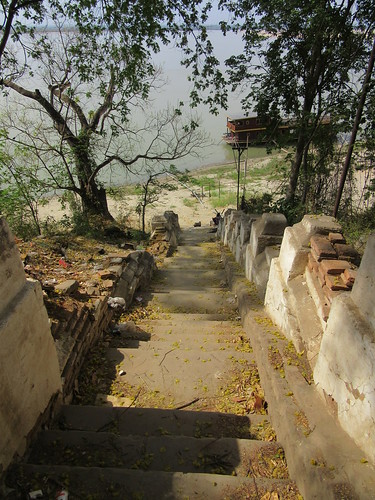
Steep steps leading to the river.
In a couple of places, electric pumps connected to long pipes were provided to lift water directly from the river to storage arrangements in the monastery compound.
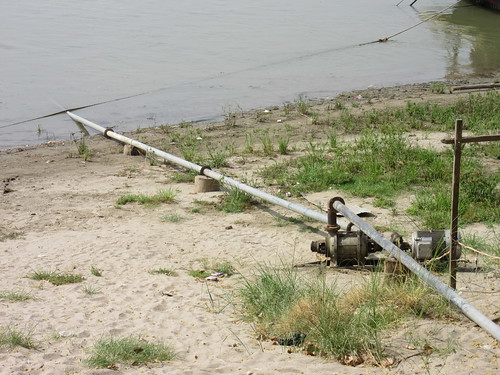 One of the electric pumps on the river bank.
One of the electric pumps on the river bank.
But my eye was drawn to a moored ship, probably little more than a hulk but with paddle boxes either side, conjuring visions of the 'Irrawaddy Flotilla' and Kipling's words "Can't you 'ear their paddles clunkin' from Rangoon to Mandalay?". There's more about Kipling's Burma and his famous poem here.
 "Can't you 'ear their paddles clunkin' from Rangoon to Mandalay?".
"Can't you 'ear their paddles clunkin' from Rangoon to Mandalay?".
Part of the fascination of the Bagan area is the sheer number of surviving pagodas - some large, some small, some in deteriorating condition, some carefully restored and built in differing architectural styles, according to their age. Within a few hundred yards of the Medical Clinic, I was able to explore a number of pagodas.
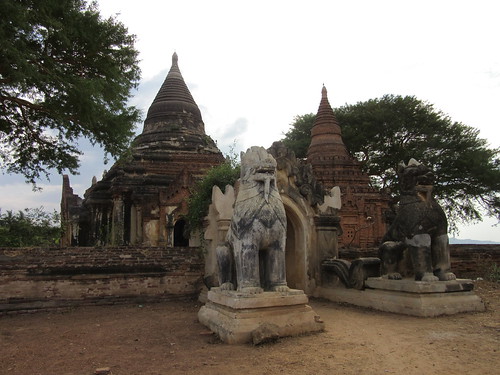 Pagodas protected by a pair of mythical Burmese lions (Chinthe).
Pagodas protected by a pair of mythical Burmese lions (Chinthe).

A pagoda in a different style.

Yet another style of pagoda.
Exhausted by my explorations, I returned to the Bagan Medical Clinic but, after observing treatments for a while, Emily and I were taken by car to our respective hotels for a relaxing evening. The next morning, we would have a chance to observe the final day of clinic opening for that week.
Go to next post on this trip.
All my posts on the Bagan Medical Clinic can be found here.
All my posts on this trip to Myanmar can be found here.
My pictures
The following albums (on Flickr) hold pictures relevant to this post:-
Bagan Clinic, Saturday 25th April 2015.
Bagan Thiripyitsaya Sanctuary Resort.
Around Bagan, 2015.
All my albums for this trip (except purely 'technical' ones) can be found here.
[Text revised, pictures added 10th and 22nd June 2015]

